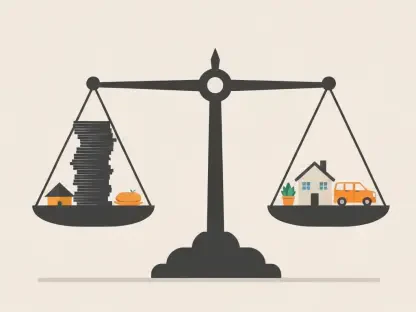The holiday season brings joy and celebration but often comes with significant financial stress. As the new year approaches, people commonly set ambitious financial resolutions, only to find them challenging to achieve over time. This article explores how replacing these ambitious resolutions with more realistic financial goals can lead to long-term financial well-being and stability, helping individuals maintain a healthier relationship with their finances.
The Pitfalls of Overly Ambitious Financial Resolutions
Each year, countless individuals make vows to drastically change their financial habits in pursuit of better fiscal stability. Many set goals such as paying off all their debt within a year, saving an enormous amount of money, or making vague promises to curb spending. While these ambitious intentions are commendable, they often set individuals up for failure due to their unrealistic nature and lack of specificity.
Financial planner Mamie Wheaton emphasizes that overly ambitious financial goals can lead to frustration and disappointment. Instead of aiming to pay off all your debt in a short period, it is more practical to focus on building an emergency fund first. This approach ensures that a safety net is in place for unexpected expenses, preventing the accumulation of additional debt. Addressing debts methodically while maintaining a buffer for emergencies helps create a more grounded financial strategy, leading to a more favorable outcome over time.
Building an Emergency Fund: The First Step to Financial Stability
One of the most critical steps in achieving financial stability is the creation of an emergency fund. Wheaton advises prioritizing saving enough to cover at least one month’s worth of expenses before aggressively tackling debt. This emergency fund acts as a buffer against unforeseen financial hardships, such as medical emergencies or car repairs, providing protection and peace of mind.
High-yield savings accounts are an excellent option for storing emergency funds, offering higher interest rates than traditional savings accounts, thus allowing your money to grow while remaining accessible. Once a sufficient emergency fund is established, you can then focus on paying down high-interest debt, particularly those with rates above 4%. This structured approach promotes financial security and prevents the impulse to use credit cards or loans in times of financial strain.
Setting Specific and Measurable Financial Goals
Vague financial resolutions like “save more money” or “reduce debt” lack the clarity needed for success. Wheaton suggests breaking down these broad objectives into specific, measurable actions that provide clear direction. For example, instead of a nebulous goal to save a large sum for retirement, set a target to increase your 401(k) contributions by a certain percentage each year. This specificity not only makes your goals more attainable but also allows you to track your progress effectively.
Smaller, incremental milestones help maintain motivation and commitment to your financial plan. Celebrating achievements along the way creates a positive feedback loop, reinforcing good financial habits and ensuring continued progress toward larger goals. This method of goal-setting transforms vague intentions into actionable, realistic steps that lead to lasting financial improvement.
Pre-Planning for Financial Resolutions
Starting financial resolutions on January 1 without prior planning is a common pitfall for many. Wheaton recommends developing a financial plan well before the new year begins, reflecting on past financial behaviors such as cash flow and spending patterns to create a strategic plan. Assessing whether your cash flow is positive, understanding your reliance on credit cards, and analyzing the use of end-of-year bonuses to offset overspending are crucial questions for this introspection.
This reflective process allows for a clearer and more focused financial plan, setting you up for success in the coming year. Instead of making spontaneous, emotionally-driven resolutions, a pre-planned approach ensures that new habits are informed by previous experiences, paving the way for more achievable and sustainable financial goals.
Aligning Financial Goals Within Relationships
Financial harmony within relationships is essential for achieving long-term goals. Wheaton underscores the importance of open and honest communication between partners regarding their financial objectives. Conflicting priorities, such as one partner wanting to save for a house while the other emphasizes retirement, should be reconciled to develop a unified plan that fulfills both parties’ needs and aspirations.
Couples should review their finances together, understanding their respective credit scores and aligning on retirement and benefit utilization goals. By establishing a collaborative approach, partners can ensure they are on the same page and support each other toward their financial aspirations. This shared effort not only strengthens your financial strategy but also reinforces the relationship, fostering mutual respect and support.
The Importance of Incremental Progress
One of the key takeaways from Wheaton’s advice is the significance of incremental progress. Instead of making grandiose resolutions that are challenging to achieve, focusing on smaller, manageable steps creates a more realistic path to financial improvement. This approach not only makes goals more attainable but also helps build positive financial habits over time.
For instance, if your goal is to save for a down payment on a house, start by setting aside a specific amount each month. As you see your savings grow, you’ll be motivated to continue, possibly finding ways to increase your contributions. This steady progress leads to long-term financial success and stability, proving that slow and steady wins the race when it comes to financial planning.
Developing a Long-Term Financial Plan
Achieving financial well-being requires more than just setting resolutions; it involves a comprehensive long-term plan. This plan should include short-term, medium-term, and long-term goals, each accompanied by specific, measurable actions. With a clear roadmap, you can navigate your financial journey with confidence and purpose, adapting to changing circumstances along the way.
Regularly reviewing and adjusting your plan is crucial to staying on track. Life circumstances change, and your financial plan should be flexible enough to adapt. Whether it’s a change in income, unexpected expenses, or new financial goals, staying proactive and making necessary adjustments ensures continued progress and long-term financial stability.
The Role of Professional Financial Advice
While the holiday season is a time of joy and celebration, it frequently brings substantial financial pressure. With the approach of the new year, it’s common for people to set big financial resolutions. However, these ambitious resolutions often prove to be difficult to stick to over time. This can lead to frustration and a strained relationship with money. To avoid this, it might be more effective to swap out these lofty resolutions for more realistic financial goals. Setting attainable goals can pave the way for long-term financial health and stability. This approach promotes a healthier connection with your finances, allowing for more sustainable progress. When goals are manageable and realistic, individuals are less likely to feel overwhelmed and more likely to stay committed. Instead of aiming for drastic changes that are hard to maintain, incremental improvements can lead to significant financial well-being. By focusing on achievable targets, people can build confidence in their financial management skills and gradually create a stable, prosperous future.









